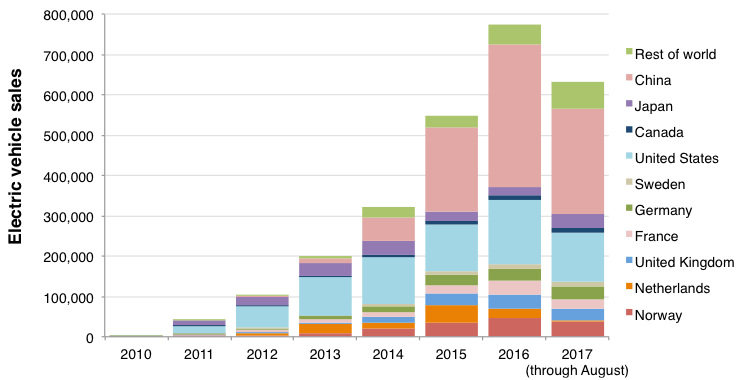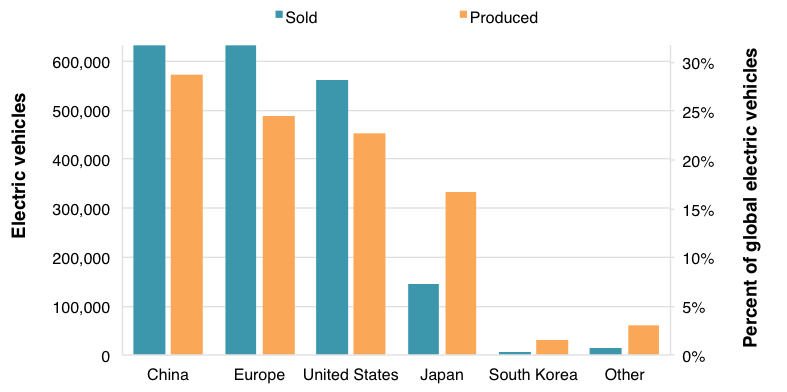A surprising key to unlocking the electric vehicle market: Utilities
Blog
The transition to electric cars: How can policy pave the way?
The pronouncements keep coming. Policymakers in France, Germany, India, the Netherlands, Norway, Scotland, and the United Kingdom announcing the phase-out of gasoline and diesel combustion cars by somewhere from 2025 to 2050. Ten US states and Canadian provinces have made similar statements. And now China — the biggest market of all — is working towards its own timetable.
This amounts to a very serious challenge to shift to electric cars; an idea that would have appeared radical if suggested a few years ago. Now it is increasingly being seen as one of the defining questions for transport ministers and auto industry leaders. What are the implications for the fast-evolving new electric car industry? Are the right policies in place to navigate the transition?
Policy action driving the market
First, we can assess the progress so far for electric car sales. The developments have mostly been in China, Europe, and the US, together representing about 90 percent of the world’s electric car sales. These markets are regulating vehicle emissions, offering well-designed incentives, deploying charging infrastructure, and rolling out consumer awareness campaigns to align the market with their electric mobility goals.
These developments show us how policy action has been driving the market. For a sense of scale, there were about two million electric cars sold globally through 2016, and it is likely that there will be three million by the end of 2017. This is impressive and unprecedented for an alternative fuel vehicle. But most national markets are still below a two percent electric share of new car sales – we are just beginning to move from innovators to early adopters.
Annual electric vehicle car sales (source: EV sales)
The above goals set out by policymakers to ban combustion would go much deeper to fully transform the industry. Most vehicles would be implicated as the affected markets represent over half of the world’s car sales. That is over 40 million annual car sales in markets that are looking to push the fleet towards electric – certainly enough to get industry’s attention. Automakers are beginning to invest in massive “giga” battery factories and move from hundreds of thousands to millions of electric cars per year to meet demand. This sends a clear signal not just to auto manufacturers, but also battery suppliers, electric vehicle charging providers, and electric power utilities.
Designing the right policies
But how can policy help make the electric revolution a reality? To take the next step, many governments are considering stronger, direct policies to steer the market towards electric. California and the nine US states that follow its Zero Emission Vehicle regulation requires the deployment of about two million electric vehicles by 2025 (up from about 400,000 today). China’s recently finalised New Energy Vehicle quota system would likely require annual electric vehicle sales of well over one million per year by 2020. The European Commission has been considering electric vehicle quotas within its post-2021 proposal to regulate new passenger cars’ CO2 gram-per-kilometre emissions. These types of policies overcome a primary barrier to mass adoption: there are too few electric car models available in most markets, and low production volume keeps their prices relatively high.
Where these electric cars will come from is also key to setting the right policies. The figure below shows not just where electric cars are sold, but also where they are made. About 97 percent of electric car production is from China, Europe, the US, Japan, and South Korea. This means that most electric cars – and also their battery packs and other components – are manufactured in a limited number regions, and most electric cars are made in the region where they are sold. Given that developing new electric car production takes years, most electric vehicles will be made in just a few regions of the world for the foreseeable future. This suggests that further development of the market might increasingly not only be about demand-side policy, but also about promoting in-country manufacturing.
Electric vehicles sold and produced by region, cumulative and percent of global electric vehicles, 2010-2016 (source: EV sales
In addition, trade policy could be explored to minimise barriers in the supply chain and importation of electric cars. For example, is it possible to use vehicle tariffs in the same way the Netherlands, Norway, and others have used their domestic vehicle taxation to promote electric cars? In major car-importing countries, setting tariffs proportional to emissions could align car imports with national goals for lower emissions – and, importantly, would avoid drawing upon a country’s domestic taxation system. Such tariff policy could be used not just for electric cars, but also perhaps to encourage imports of electric vehicle materials, components, and charging equipment. Some countries such as India have already autonomously reduced duties on electric vehicle spare parts. Moreover, under the Paris Agreement, the Bahamas, Saint Lucia, and Saint Vincent and the Grenadines mention the reduction of their import tariffs on certain types of vehicles, including electric cars.
Governments face major clean air and climate mitigation challenges to dramatically reduce the health and environmental impacts from the transportation sector. These justify and necessitate stronger policy action, and electric vehicles are a key part of the solution. With more attractive longer-range car models on the way, now is an ideal time for policymakers to act and design policies that encourage electric car sales, manufacturing, and imports.
A sustained effort
The unprecedented scale of the challenge to electrify the fleet calls on us to put the most powerful policy tools to good use. Steering the market to electric vehicles will require sustained policies that address the barriers of model availability, cost, charging, and consumer information. At stake, more narrowly, is the speed with which any given market will get to a zero-emission fleet. More broadly, if more governments act in unison with a strong and comprehensive suite of support policies, that destination will be reached sooner.


